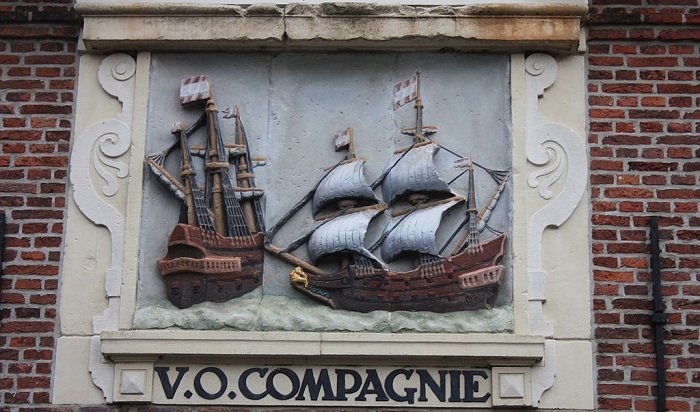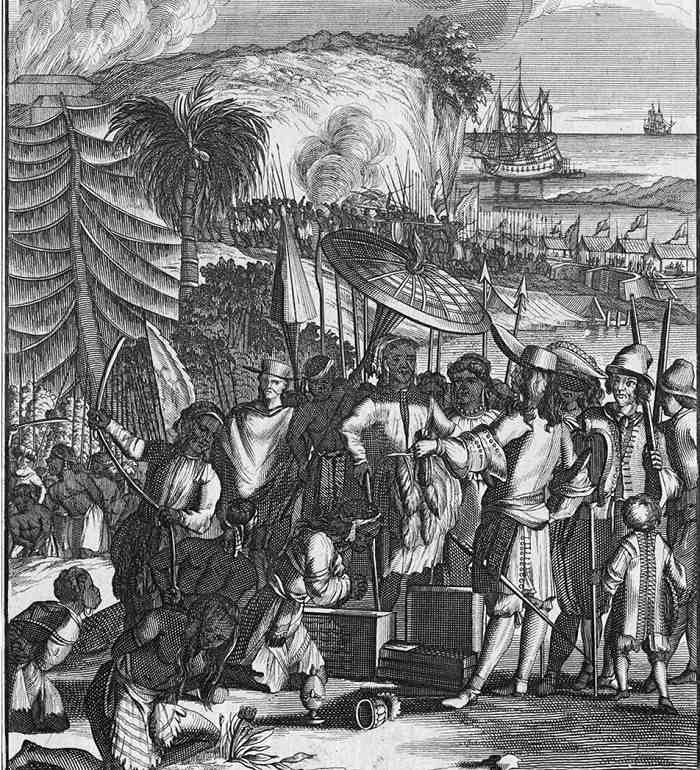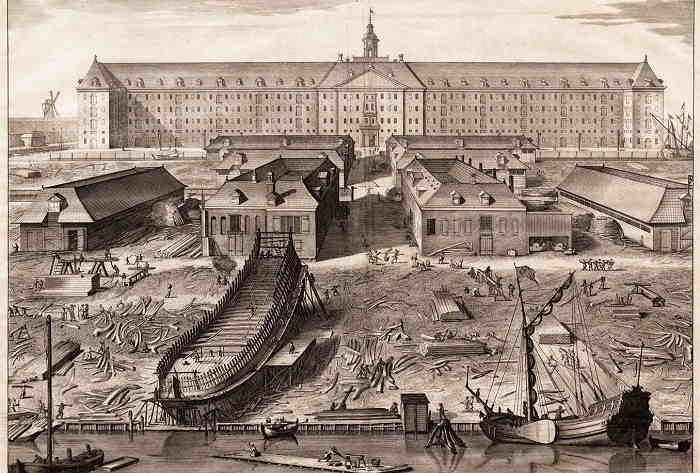Dutch East India Company
The Dutch East India Company, in Dutch, the Vereenigde Oostindische Compagnie (VOC) was a government-backed military-commercial enterprise founded on March 20, 1602. It was launched as a chartered company to trade with India and Indianised Southeast Asian countries. Formed by a government-directed amalgamation of different rival Dutch trading companies VOC diversified in different commercial and industrial activities. It was considered an international arm of the Dutch Republic along with the Dutch West India Company and a war instrument in the Dutch War of Independence against the Spanish Empire and Iberian Union. VOC prospered and existed for around 200 years before declining as a trading and sea power by the late 17th century and finally dissolving in 1799.
(Source: https://en.wikipedia.org/wiki/Dutch_East_India_Company, https://www.britannica.com/topic/Dutch-East-India-Company
What was the actual purpose of the Dutch East India Company?
Foundation of VOC was laid as early as the 1590s when the Dutch started challenging Portuguese monopoly in East Asia. In northern Europe, Antwerp held prominence as a distribution centre prior to the Dutch Revolt. An international syndicate including the German Welsers and Fuggers as also Spanish and Italian firms was used by the Portuguese after 1591. Hamburg was used by them as their principal northern port for distributing goods. This led the Dutch merchants to go out of the trade. However Portuguese trade system failed to meet growing demand, especially for pepper. Relatively inelastic demand of spices led to sharp rise in prices of pepper as supply fell short. Meanwhile the Dutch Republic was at war after the Portuguese crown united with the Spanish crown in a personal union in 1580. The Dutch military made the Portuguese Empire an obvious target for invasions and attacks. Such developments encouraged Dutch merchants to get into intercontinental spice trade. Moreover information on secret Portuguese trade routes and practices were also obtained by several Dutchmen like Cornelis de Houtman and Jan Huyghen van Linschoten thus making it easier for the Dutch merchants.
 Image Source: https://en.wikipedia.org/wiki/Dutch_East_India_Company
Image Source: https://en.wikipedia.org/wiki/Dutch_East_India_Company
The ventures of Dutch merchants proved highly prospering with some ships returning with profit of around 400%. The merchants eventually started investing in many ships simultaneously to minimise risks. However the expeditions proved to be very high risk ventures for investors including risks of shipwreck, disease and dangers of piracy. The Dutch formed an anti-Portuguese alliance with the Muslim Hituese on Ambon Island in 1600. It led the Portuguese to surrender their fort in Ambon while the Dutch earned sole right to purchase spices from Hitu. Same year the English adopted the cartel system to manage risk and control supply by forming a monopoly enterprise, the English East India Company. The Dutch government treaded the same path in 1602 and sponsored formation of VOC. The company was the wartime idea of the States General of the Netherlands and Dutch republican statesman Johan van Oldenbarnevelt. VOC was formed by a government-directed amalgamation of different rival Dutch trading companies. Its formation led to simultaneous funding of hundreds of ships by hundreds of investors so as to minimize risk.
VOC was originally launched as a chartered company on March 20, 1602 to trade with India and Indianised Southeast Asian countries. It was granted a 21-year monopoly on the Dutch spice trade by the Dutch government. It was a proto-conglomerate company that diversified in various commercial and industrial activities. These included production and trade of East Indian spices, South African wine and Formosan sugarcane; shipbuilding; and international trade, particularly intra-Asian trade. Apart from securing the state’s trade in the Indian Ocean, the purpose of VOC also included aiding the Dutch war of independence against Spain.
(Source: https://en.wikipedia.org/wiki/Dutch_East_India_Company, https://www.britannica.com/topic/Dutch-East-India-Company, https://www.thoughtco.com/the-dutch-east-india-company-1434566)
History of the Dutch East India Company – Why Did The Dutch Come to India?
During seventeenth century, for some time, the VOC thrived in monopolising trade in cloves, mace and nutmeg. These spices were sold by VOC in India and Europe at prices amounting to fourteen to seventeen times the amount they paid in Indonesia. Surge in profits of the Dutch ruined local economy of the Spice Islands. VOC was granted trade monopoly in the waters by the Dutch government between the Cape of Good Hope in Africa and the Straits of Magellan, the most vital natural passage between the Pacific and Atlantic oceans. The charter of VOC gave it the power to conclude treaties with native princes. It also empowered VOC to construct forts and maintain armed forces apart from continuing its administrative operations via officials who were required to take vow to be loyal to the Dutch government. The capital of VOC increased by over 50% after it captured the 1500-ton carrack merchant ship of the Portuguese, the Santa Catarina, off the coast of Singapore in February 1603. The Dutch established their first permanent trading post in Indonesia same year in Banten, West Java. The post of Governor General, who became the principal administrator of the Asian affairs of VOC, was established by the company in 1610. However a 17 shareholders body, the Heeren XVII, that represented various chambers, officially carried on to have full control. Anglo-Dutch competition in the spice trade sparked in the early 1600s leading to intense rivalry. The eventual ‘Amboyna massacre’ (1623) witnessed arrest, torture and execution of 10 Englishmen on Ambon Island for conspiring against the Dutch government. The conflict remained a source of tension for both nations until late in the 17th century. The English had to back off from most of their Indonesian affairs excepting for trading in Banten.
 Image Source: https://commons.wikimedia.org/wiki/File:Natives_of_Arrakan_sell_slaves_to_the_Dutch_East_India_Company_(1663).jpg
Image Source: https://commons.wikimedia.org/wiki/File:Natives_of_Arrakan_sell_slaves_to_the_Dutch_East_India_Company_(1663).jpg
After viewing VOC as an emerging political and economic power in Asia, the new Governor-General of the company Jan Pieterszoon Coen relocated its headquarters from Ambon to Batavia (present-day Jakarta) in 1619. Batavia became the center of Asian trading network of VOC. It strengthened monopolies on local produce through non-indigenous cash crops and along with the colonial administration gradually went on to absorb surrounding territory to protect commercial interests. The company traded across Asia including using silver and copper from Japan to trade with India and China for textiles, cotton, porcelain and silk. VOC backed Christian missionaries. It introduced European concepts and technology to Asia and traded modern technology with Japan and China. The VOC later acquired the port of Galle, Ceylon, from the Portuguese in 1640 and captured Colombo with the help of King Rajasinghe II of Kandy in 1658. VOC secured monopoly over cinnamon after it occupied the coastal regions following expulsion of the Portuguese from the area. It then conquered the Malabar Coast from the Portuguese resulting in forcing them out almost entirely from the Indian west coast.
VOC joined hands with many local lords in the Painan region who revolted against the Aceh Sultanate and signed the ‘Painan Treaty’ with them in 1663. This led the company to build a trading post in the region and gradually garner a trade monopoly there, particularly in gold trade. The Dutch also operated many mints including in Pondicherry, Pulicat, Nagapatam, Masulipattam and Cochin. With more than 150 merchant ships, 40 warships, a private army of 10,000 soldiers, employees of around 50,000, and a 40% dividend payment on the original investment, by 1669 VOC emerged as the richest private company ever. A transcontinental employer, VOC was an initial pioneer of outward foreign direct investment. It became the first formally-listed public company of the world when it issued bonds and shares of stock extensively to the general public in the early 1600s. An upsurge of Indo people (people of mixed Indonesian and European descent) was witnessed after arrival of VOC employees in the 17th century thus expanding the population of Indos in pre-colonial history.
(Source: https://en.wikipedia.org/wiki/Dutch_East_India_Company)
Dutch East India Company Trading Posts and Settlements
Settlements and trading posts of VOC existed in Dutch India (1605–1825) on the Indian subcontinent. Dutch India was categorized into the directorates Dutch Suratte and Dutch Bengal, the commandment Dutch Malabar, and the governorates Dutch Coromandel and Dutch Ceylon. Furthermore the Dutch Indies were the Dutch West Indies (presently Suriname and the erstwhile Netherlands Antilles) and the Dutch East Indies (presently Indonesia). After establishing the first permanent Dutch trading post in Indonesia in Banten, West Java in 1603, the VOC established many other settlements throughout the early 1600s. The Batavia post was established in 1611. The VOC merchants established the Dutch Coromandel and then Dutch Suratte and Dutch Bengal in 1616 and 1627 respectively. In 1656, Ceylon was conquered by the Dutch from the Portuguese. Five years later the Dutch seized the Portuguese forts on the Malabar coasts. However the Dutch influence gradually dwindled in the second half of the eighteenth century. All Dutch colonies were surrendered to the British “for safekeeping” following orders in Kew Letters to prevent them from being overrun by armed forces of the French Republic. VOC’s power in Malabar declined after being defeated by Travancore King Marthanda Varma’s army in the Battle of Colachel (1741). Dutch Coromandel and Dutch Bengal, which the Dutch rule restored because of Anglo-Dutch Treaty of 1814, were returned to British rule due to provisions of the Anglo-Dutch Treaty of 1824. The Dutch had to forgo their last trading posts in India by mid-1825.
The trade post of VOC in the artificial land of Dejima off the coast of Nagasaki marked the only place where Europeans were allowed to trade with Japan for over 200 years. An outpost at the Cape of Good Hope (presently Cape Town, South Africa) was established by Jan van Riebeeck in 1652. It eventually became the Cape Colony, a fully developed colony with settlement of considerable Dutch and other European populace. Indian slaves were imported in the Cape Colony as also on the Spice Islands. Other VOC trading posts established during the seventeenth century included in Persia, Formosa (presently Taiwan), Siam and Malacca.
(Source: https://en.wikipedia.org/wiki/Dutch_India, https://en.wikipedia.org/wiki/Dutch_East_India_Company)
 Image Source : https://commons.wikimedia.org/wiki/File:Voc.jpg
Image Source : https://commons.wikimedia.org/wiki/File:Voc.jpg
Conflicts and Wars
During the course of its operations, the commercial objectives of VOC led it to get involved in several conflicts. The conflicts were often connected to Dutch military conflicts, one of the most famous being that with the British East India Company. VOC was originally a government-supported military-commercial organisation. Apart from its commercial objectives, from the very outset, VOC remained an instrument of war of the Dutch Revolt against Spanish Empire. It was looked upon as the international arm of the Dutch Republic and held quasi-governmental powers in its foreign colonies. These included powers to establish colonies, strike its coins, engage in wars, negotiate treaties and imprison and execute convicts. Conflicts involving VOC included Dutch conquest of the Banda Islands (1621), Amboyna massacre (1623), Cambodian–Dutch War (1643–1644), Javanese Wars of Succession (between 1677 and 1755) and the Batavia massacre (1740) among many others.
Source:https://en.wikipedia.org/wiki/Dutch_India, https://en.wikipedia.org/wiki/Category:Military_history_of_the_Dutch_East_India_Company
Decline and Fall of the Duth East India Company
A slow decline of the VOC between 1720 and 1799 was witnessed. The major issues causing such downfall included socio-economic changes in Europe; shift in power balance; political and economic changes in Asia leading to steady erosion of intra-Asiatic trade; corruption and non-performance of duties by VOC personnel; and less successful financial management among others. The capital of the company remained almost the same in its over 200 years run while its dividend policy led it to strive with little capital for reinvestment. Thus VOC started issuing debt in the 1630s. The debt/equity ratio only increased with time touching 18 in the 1780s. The remaining power of VOC in Asia was devastated following the Fourth Anglo-Dutch War (1780–1784). The VOC was nationalised on March 1, 1796, by the new Batavian Republic. The company’s charter underwent renewal several times, however VOC was finally dissolved in 1799. Great Britain occupied most of the possessions of the company during the Napoleonic wars. However following emergence of the new United Kingdom of the Netherlands, the Anglo-Dutch Treaty of 1814 restored some such possessions to this successor state of the Dutch Republic.
(Source: https://en.wikipedia.org/wiki/Dutch_East_India_Company)


